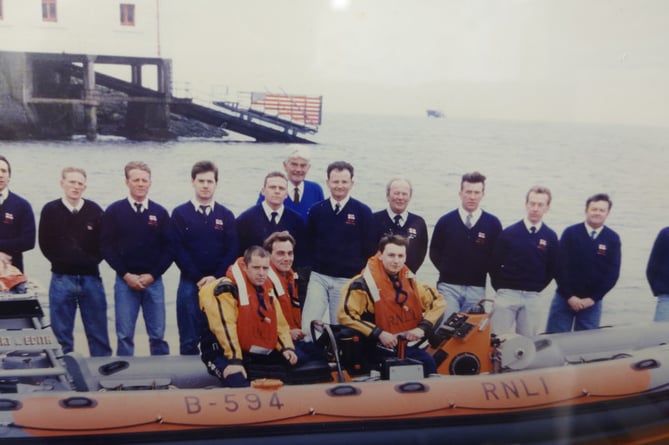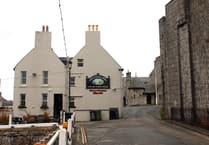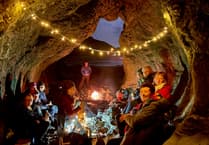’It was really emotional,’ he said. ’It’s a big family and I haven’t been divorced from that family, I’m still part of it and will be forever. It’s not something you can just walk away from.’
At 26 years old, Mr Crellin joined the Port Erin RNLI station, following in the footsteps of his father.
’I was a very young boy in the 1960s, looking up to his mum, who was with the Ladies Lifeboat Guild [formed to raise money for the charity] and his dad, who was with the lifeboats in Port Erin,’ Mr Crellin said.
’When I got myself settled working, my dad was still on the lifeboat, so I joined the crew. Port Erin was my first and only station.’
The 62-year old undertook training to become a volunteer, which he described as ’nothing like today’.
He said: ’When I first joined on an all-weather lifeboat called the Osman Gabriel, it was "there’s your kit, get on the boat".
’It was a process of learning when we did exercises, once a month on a Sunday morning. And it was just a case of stand there, look and pick it up more than anything else. There was very little structured training and you’d just learn what you did on the boat.
’The training that you now get as a lifeboat crew, and also training ashore crew and officials of the lifeboat, whether it be board operations manager or a deputy launch authority, is absolutely second to none and has changed from my time out of all recognition.’
When asked if he took to the water easily, Mr Crellin said: ’I’ve enjoyed being on the water in boats all my life really. I’ve always had boats in the family.’
Having finished his training in 1992, he went on to become a helmsman - the person who steers the lifeboat - on the B-Class Atlantic 21 B-594 Herbert and Edith lifeboat. He described it as his favourite role, saying: ’I often say that once you become non-seagoing anymore, to sit in the lifeboat house and launch the boat and just listen to the radio is a very difficult thing to do once you’ve been active crew. You tend to worry more.’
The man from Port Erin added: ’When the RNLI changed Port Erin station from being an all-weather lifeboat station to an inshore lifeboat, we got the Atlantic 21 which was originally designed in Atlantic College in Wales, and, of course, some of the older crew had to retire. We ended up with quite a young crew and that was the very first structured training that the lifeboat started to take on.
’We all went down to the Isle of Wight where the RNLI had their inshore lifeboat training station and we spent a week training around the island and in the River Medina, being capsized with the boat in the water, connected to a crane. The boat was capsized with you in it.
’It was good fun, I enjoyed it because when an inshore lifeboat capsizes, which thank heavens is very rare in the RNLI, the boat stays upside down until the crew operate an inflation mechanism to rewrite it. So you have to get out from underneath the boat first of all, and then go down to the back of the boat and operate the inflation unit and then that flips the lifeboat back over. It’s all very well done because as the lifeboat turns over, the engines automatically stop, they waterproof themselves, lights come on underneath the capsized boats and you can see what goes on.
’It’s all very, very well done and safety of the crew is paramount now to the RNLI.’
Mr Crellin’s most memorable rescue was when he assisted in saving two students from the Marine Biological Station in Port Erin who had sailed their dinghy in rough weather.
’I had to save them off the bottom of the cliffs of Bradda Head. That was quite a hairy moment really.
’They were 20 feet up the cliff. They’d climbed up that far and obviously couldn’t get any further, so you have to put the anchor out on the lifeboat and go in backwards and take them off the cliff that way.’
In 2004, Mr Crellin, aged 45 at the time, retired from seagoing duties to become part of the deputy launch authority, which helps the stations by receiving the initial service call from HM Coastguard and making the launch request to the volunteers.
He added: ’I had to retire from helmsman because that was the policy of the time.
’They had worries about old men being at sea, although I was probably one of the fittest there but there we go!’
He continued in that role until the lifeboat operations manager stepped down and he took over that position.
’My father was lifeboat operations manager once too which was a proud moment for me. I was also very proud that my children went on to be crew.’
His daughter Rachel joined in 2004 and his son Richard in 2006, both 17 years old when they started.
Mr Crellin said his favourite lifeboats to work on were the Osman Gabriel, his first lifeboat, and the first inshore lifeboat at Port Erin, the Atlantic 21.
He added: ’The Osman Gabriel, which was an all-weather lifeboat, was slow compared to our present lifeboats, it was made of wood. It was a fantastic sea boat, as all lifeboats are, they’re designed to do what they do.
’They’re just designed to save lives and they’re all fantastic vessels.’
Mr Crellin was feeling withdrawal symptoms after retiring only three weeks ago, saying: ’Just at the end of last year, I retired from another voluntary post that I did for over 30 years in conjunction with the RNLI, so I’m feeling withdrawal symptoms from both of them to be honest.
’I was a commissioner for Port Erin for 34 years and on the crew of Port Erin and on the management side for 36 years, so 70 years voluntary service altogether, I think is not bad.’
He has seen Port Erin’s lifeboats launch more than 200 times across his career. As a crew member and helmsman, he saw 103 launches with 13 lives rescued from shipwreck, along with 98 launches as a part of the deputy launch authority and in his role as lifeboat operations manager.
During his time with the station, Mr Crellin has overseen a number of volunteers growing into their roles.
The former commissioner said: ’It’s one of the best things apart from saving lives at sea, seeing a young person arriving at the lifeboat station at 17 wanting to join the crew and you see them grow into extremely competent adults who are absolutely committed to the service in every way. That in itself is a great thing to look at.
’I suppose I was exactly the same when I joined at 26. It’s part of this whole ethos of the RNLI to look after the whole person and not just say "right, there’s a boat, off you go".
’The RNLI spend a lot of money training people so they can do the job when they’re at sea but also to make sure that they come back safely, which is paramount.’
He said he would miss the ’fellowship of the crew’ the most.
’I didn’t want to give my RNLI career up because once you join, it’s very, very difficult to leave, because of the camaraderie and the fellowship of it all. You feel very proud of the RNLI in the work that it does. It’s something that gets under your skin. I’ve made such great friends within the RNLI that I’ll keep for a lifetime. I’m already missing Sunday mornings with cups of tea and biscuits while we’d talk about lifeboats!’
Mr Crellin added: ’I wish Port Erin lifeboat station and the RNLI the very best for the future.’




